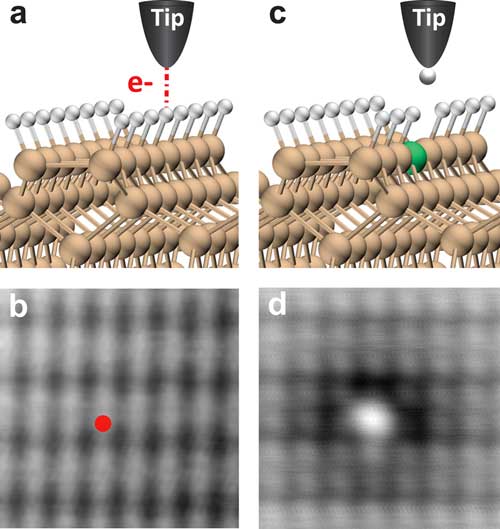| Posted: Jul 23, 2017 | |
Functionalizing an AFM tip with a single hydrogen atom(Nanowerk News) Researchers demonstrated the controlled vertical manipulation of a single hydrogen (H) atom using the tip of an atomic force microscope (AFM) sensor and its application in characterizing and engineering silicon dangling bond (DB)-based structures of relevance to nanoelectronic devices. |
|
| Reporting their findings in ACS Nano ("Atomic White-Out: Enabling Atomic Circuitry through Mechanically Induced Bonding of Single Hydrogen Atoms to a Silicon Surface"), a research team in Canada shows that following a localized tip induced excitation on the Si-H surface, a single hydrogen atom is desorbed and could be either deposited on the surface with stable imaging in scanning tunneling microscope (STM) and AFM or transferred to the tip apex. | |
 |
|
| Illustration of the tip-induced manipulation that can result in tip functionalization with a single hydrogen atom. (a) Ball-and-stick model of the H-Si(100)-2×1 surface. (b) Typical defect-free empty state STM image using a nonfunctionalized tip and showing the dimer structure of the surface. The red dot indicates the position of the STM tip when the electronic excitation sketched in (a) is applied. (c) Ball-and-stick model of a silicon atom with a dangling bond in green and a H-functionalized tip resulting from the tip-induced desorption. (d) Typical STM image of a DB acquired with a H-functionalized tip showing a characteristic STM contrast enhancement. Both STM images were acquired in constant current mode with a set point of 50 pA at +1.3 V. (© ACS) | |
| The scientists identified the single H atom functionalized tip through a unique signature in frequency shift vs displacement curves (i.e., Δf(z)) and a characteristic enhancement of STM images in filled and empty states. | |
| By bringing the H-functionalized tip apex very close to a DB in the absence of bias and current, a covalent bond between the single hydrogen and silicon atoms is formed. | |
| Subsequent changes in the STM images and Δf(z) curves confirmed that this mechanically induced reaction results in the passivation of the DB with the hydrogen from the tip apex. | |
| "It has become clear that CO-functionalized tips are effective for characterization of adsorbed molecules on metal surfaces," the authors conclude their report. "It is clear also that accessible and effective tips are required for other systems of study. Preparing and identifying such a tip is described in this work. Moreover, the Hfunctionalized tip is shown to allow characterization and also induce changes in DB-based structures on the H-Si(100) surface through selective mechanically induced hydrogen passivation, or 'capping'." |
 By
Michael
Berger
– Michael is author of three books by the Royal Society of Chemistry:
Nano-Society: Pushing the Boundaries of Technology,
Nanotechnology: The Future is Tiny, and
Nanoengineering: The Skills and Tools Making Technology Invisible
Copyright ©
Nanowerk LLC
By
Michael
Berger
– Michael is author of three books by the Royal Society of Chemistry:
Nano-Society: Pushing the Boundaries of Technology,
Nanotechnology: The Future is Tiny, and
Nanoengineering: The Skills and Tools Making Technology Invisible
Copyright ©
Nanowerk LLC
|
|
|
Subscribe to a free copy of one of our daily Nanowerk Newsletter Email Digests with a compilation of all of the day's news. |
